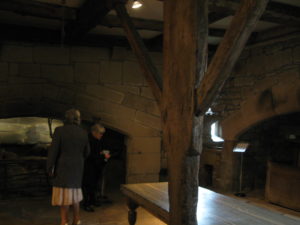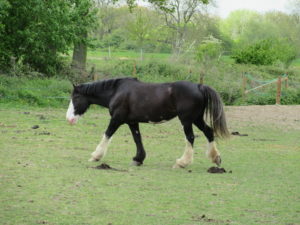No more than to be expected: late April anywhere in England can produce weather for all four seasons. For a wedding at Haddon Hall we needed formal clothes for sure, but had to protect them and ourselves with overcoats, gloves and waterproofs. All worth it though.
There was snow on the High Peak and rain in the Dales, new lambs in pastures and a few trees in leaf. Our farming friends, braving a long day after attending to a calving cow in the small hours, were surprised to hear oaks were already in bud in Suffolk. No surprise to find the gardens at Haddon Hall limited in colour, although we were not there for gardens other than to please the photographer.
Staff at the Hall had volunteered to attend us on the day, for which we were really grateful. A quick look at the gardens and the view across the dale, then they took us inside for a privileged tour of the rooms for ceremony and reception.
How the hall had survived two centuries without inhabitants is amazing, as well as a tribute to the skills of medieval builders. Local timber had not only decorated but also fortified the roof. Close inspection at eye level certainly attests to decorative quality.
Glass, while not more than wall as at Hardwick, is extensive and ingeniously angled within the leads to catch every aspect of light and draw it inside the long gallery. As the indoor equivalent of terrace or garden path it would have been very frequently in use for exercise in days before kagouls and fell boots. In our case it was an ideal location for drinks and canapes after the ceremony.
Of course we visited the great hall and the wonderful kitchens – if not as huge and comprehensive as at Hampton Court at least as interesting. During the early years of the last century a collection of dole cupboards had been made. Some of these had no doubt been used in the MIddle Ages for distributing bread to the local poor. The kitchen had originally been separate for the hall as a precaution against fire, and is still connected by a lengthy and uneven passage. We were intrigued to see, even so, that scorch marks believed to be apotropaic – to protect from fire – were on a crown post where they would not have been a good location for lighting.
Fire in the hearth where the ceremony was held was welcoming, although as ever likely to toast one side of you while the other was chilled, but preferable to the double chill of guests on the other side.
For photographs we were back in the great hall, then the base court and finally the terraced gardens, early flowers in crevices on the walls and formal shrubs clipped and green. There was even a chance for the curious to check the comforts of rear seats in the 1934 vintage Rolls that the chauffeur explained was anything but a comfort to drive without of course power steering or adequate springs.
So despite visiting for other than touristic reasons we had seen enough to interest us in a return to Derbyshire and closer attention to the splendour of Haddon Hall.










